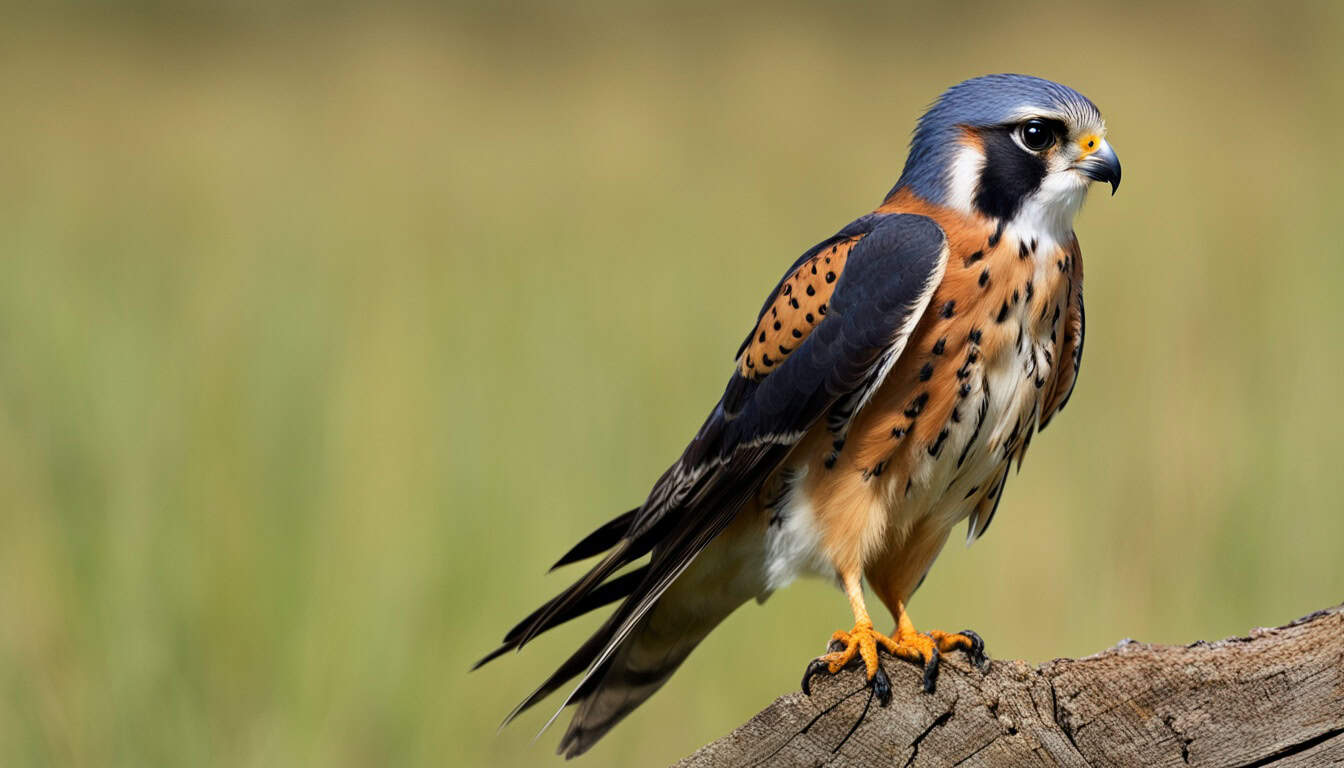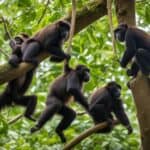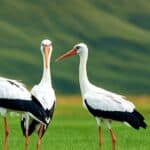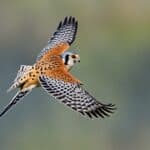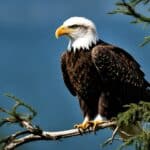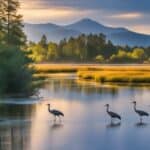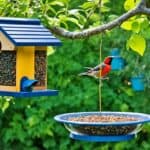Have you ever wondered how the tiny American kestrel, North America’s smallest falcon, manages to span two continents?
The American kestrel calls both North and South America home. Some stay in one area all year, while others travel long distances. They might go as far as Central America for the winter.
You can see American kestrels in various places. They are often seen in mountains and at bird migration spots in the fall. This shows how well they adapt to different living conditions.
Introduction to the American Kestrel
The American Kestrel is the smallest falcon in North America. It’s known for being agile and brightly colored. Bird lovers and scientists find them very interesting because of their hunting skills.
Brief Overview
American Kestrels live in many places across the continent, showing they can adapt well. You might see one flying over fields or sitting on city wires. Their looks and actions stand out wherever they are.
Identification and Characteristics
To recognize an American Kestrel, look at its colors. Males have a blue-gray head and wings. They match these with an orange-red back and tail. Females are similar but have more brownish tones. These colors help them hide and hunt.
American Kestrels can hover in the air, searching for food. This, along with their loud, sharp call, makes them easy to spot. Nest boxes help them as they face a loss of natural homes. Knowing these details helps us understand and enjoy these amazing birds.
Geographical Distribution of American Kestrels
The American Kestrel is found in many places, from Alaska to Central and South America. This bird moves around a lot. It goes where the weather is good and there is food.
North America
In North America, Kestrels live as far up as Alaska. They like open places like grasslands when they have babies. When it gets too cold, they fly south to warmer areas.
Central and South America
In Central and South America, Kestrels show up from the north in winter. You can see them in Venezuela and Colombia then. This trip helps them find food and stay alive.
Caribbean Islands
In places like Cuba and Puerto Rico, American Kestrels stay all year. They are a bit different from those on the mainland. This shows how good they are at finding homes in different places.
| Region | Presence |
|---|---|
| North America | Breeding and migratory |
| Central America | Wintering |
| South America | Wintering |
| Caribbean Islands | Year-round |
American Kestrels live over a wide area. This shows they can live in many different places. It’s important to protect where they live to help them keep surviving.
What is the range of the American kestrel?
The American kestrel lives in a big area that changes from season to season. In the summer, they can be found all the way from the north to the tropics. This shows they can live in many different places.
However, in the winter, their range shrinks. They go to places that are warmer and have what they need to live. The places they go are influenced by where their food is, the weather, and how people use the land.
This bird’s migration habits are key to their survival. They fly to find food and good places to raise their young. So, they move around to live where it’s best for them.
The weather and food also play a big part in where the kestrels are found. If it gets warmer, they might move farther north. Cold winters can make them stay in the south. Places with lots of small animals and bugs attract more kestrels.
But, what people do with the land matters too. Building homes, farming, and cutting down forests can change where kestrels can live. It can make it easier or harder for them to find a good place.
Breeding Range of American Kestrels
American kestrels are found throughout North America, showing they can live in many places. These colorful raptors pick their bird breeding habitats with care.
Breeding Habitats
They love open spaces so they can easily find food. Places like grasslands, farms, and deserts are perfect for them. These areas are great bird breeding habitats because they have everything the kestrels need to raise their babies.
Preferred Nesting Sites
For nesting, kestrels really like natural or fake spots they can hide in. They might choose tree holes, cliffs, or even man-made places. In spots where natural homes are rare, man-made boxes are a huge help. Before the females arrive, males pick and protect these spots for breeding.
| Habitat Type | Characteristics |
|---|---|
| Grasslands | Vast open spaces, abundant prey. |
| Agricultural Fields | High prey concentration, accessible hunting grounds. |
| Deserts | Dry, open terrain with sporadic prey. |
Migratory Patterns of the American Kestrel
Understanding the migratory patterns of the American Kestrel shows us how it survives. These small birds travel long distances for the seasons and places to live.
Migration Routes
American Kestrels have specific migration routes across North America. They fly from the north to the south for winter, passing through various regions. People can see them on their journey, especially in spots where they often fly over.
On their path, they go through different altitudes, moving over mountains and through valleys. This shows the great skill these birds have in navigation.
Seasonal Movements
American Kestrels move with the seasons, showing how they adapt to the world around them. Spring and summer find them in northern areas. They live in fields and find spots to build nests. As it gets colder, they head south, looking for places with more food and warmth.
During this trip, their habits change. They might be seen flying low, looking for bugs and small animals in the fields below.
Nonbreeding Range and Wintering Grounds
In the winter, American Kestrels fly to the southern U.S., Mexico, and Central America. An interesting thing happens here. Males and females choose different living spaces. Females like open areas like fields and deserts while males prefer dense forests.
Where kestrels spend their winter is mainly decided by food and safe places to rest. These birds do well in human-made spots, using them for shelter. They’ve been seen a lot in places like Florida and Texas, showing they can live in different areas.
| Region | Nonbreeding Range | Habitat Preference |
|---|---|---|
| Southern United States | High | Open fields for females, wooded areas for males |
| Mexico | Moderate | Farmland and mixed forests |
| Central America | Moderate | Various including savannas and human settlements |
Learning about where American Kestrels spend the winter teaches us about their needs. This information is key for protecting and helping their numbers grow. It guides us in how to better care for their environment.
Habitat Preferences and Requirements
It’s key to understand what the American kestrel habitat requirements are to help the species grow. These birds are very versatile in where they can live, using many different places.
Open Areas and Fields
American kestrels like to be in open areas and fields. These places are good for hunting, as they find insects and small vertebrates. They use spots like fence posts and wires to watch for prey.
Urban and Suburban Environments
American kestrels can also thrive in urban and suburban environments. They nest and hunt around buildings and bridges. This shows they can live in a variety of places.
Forest and Woodland Edges
Kestrels are not just in open places; they also live near forests and woodlands. These spots are great because they offer shelter and a place to hunt. They get to enjoy the prey of open areas while hiding in the woods.
| Habitat Type | Key Features |
|---|---|
| Open Areas and Fields | Prevalence of prey, perching sites like poles and wires |
| Urban and Suburban Environments | Nesting in buildings and artificial structures, diverse prey options |
| Forest and Woodland Edges | Combination of cover and open hunting grounds |
The American kestrel habitat requirements show that we need to protect many kinds of places. From open lands to city buildings, kestrels find ways to live and keep going.
Factors Influencing American Kestrel Distribution
American Kestrels’ distribution is shaped by many elements. These include where they choose to live in different places. Knowing about these elements helps us understand what they need to thrive and how we can protect them.
Climate and Weather
The weather and climate greatly affect where American Kestrels are found. They need certain conditions to survive. For example, mild climates with consistent weather support them, especially during the breeding season.
Availability of Prey
The amount of food (prey) determines where American Kestrels live. They eat insects, small mammals, and birds. Areas with plenty of these food sources are good for them. But, changes in prey numbers due to environmental issues or human activities can force them to move.
Human Activity and Land Use
People’s actions also impact the kestrels. Building cities, farming, and cutting down forests all lower their living space. However, putting up nest boxes can help them find new places to live. Sometimes, cities can even offer more food, helping kestrels survive in surprising spots.
Conservation Status and Efforts
American kestrel populations are dropping, causing concern. Conservation efforts are in place to fight this decline. Knowing the main threats these birds face is key to helping them.
Threats to American Kestrels
American kestrels face many dangers. These include losing their homes to cities and farms. They also struggle to find places to raise their young because of other birds.
Chemicals used in farming make food scarce for kestrels. This lowers their chances of survival. Changing climates also harm them, making it hard to find food and shelter.

Conservation Initiatives and Strategies
There are many efforts to save American kestrels. Programs watch over their numbers and find out what harms them the most. The American Kestrel Partnership is a big help. It does research and shares plans for birdhouses with everyone.
Building birdhouses has been a big success. It gives kestrels a safe place to nest, making up for lost natural spots. Protecting open lands is also important. It makes sure kestrels have enough room to find food and start their families.
Working together, groups, the government, and local people are making a difference. They aim to overcome the dangers kestrels face. This cooperation hopes to see kestrels grow in number again and thrive.
How to Spot American Kestrels in the Wild
Want to see American kestrels in the wild? Keep these strategies in mind. Look for them on fence posts or utility lines. They also hover over open fields, hunting for prey. These spots give them a good view of their hunting grounds.
In the breeding season, check out areas with lots of space and places to nest. Watch for their unique flying and sharp turns. American kestrels can stay in one place mid-air, which is special for a raptor.
For seeing their migrations, places like Cape May in New Jersey are great. In the fall, many kestrels fly south. Listen for their “killy-killy-killy” call to find them. This sound helps locate them, even when hiding.
Knowing how and where to look helps you see American kestrels. They are amazing to watch, whether sitting, hunting, or flying south. Enjoy spotting these colorful falcons if you love bird watching.
FAQ
What is the range of the American kestrel?
The American kestrel can be found all the way from North to South America. They live in the south all year round, while others travel to Central America for the winter. You might see them flying over mountains or stopping at bird watching points during their fall travels.
What are the key identification characteristics of the American kestrel?
The American kestrel is the North America’s tiniest falcon. Males have blue heads and wings but rusty red backs and tails. Females show red on their wings, back, and tail. They hunt with great skill and make a high-pitched “killy-killy-killy” sound.
Where can American kestrels be found in North America?
In North America, American kestrels are seen from Alaska to northern Canada, going down to the south of the United States. They like open areas with a lot of space to hunt. They make nests in both trees and in man-made holes.
Do American kestrels migrate to Central and South America?
Yes, during fall, American kestrels fly to Central America and sometimes even to parts of South America for the winter. This long trip is done by many of these birds from Canada and the U.S.
Are there subspecies of American kestrels in the Caribbean Islands?
Yes, the Caribbean Islands have their own types of American kestrels. These birds look different from the ones on the mainland in terms of color and size.
What are the breeding habitats of American kestrels?
In the breeding season, American kestrels pick large areas across North America to live in. They look for places like fields and open spaces that have a lot of food. They often nest in holes in trees or use special nest boxes made for them.
What are the migratory patterns of the American kestrel?
American kestrels move from their northern homes to the south for the winter. Their journey can cover the whole continent. They’re often seen at places where many birds stop to rest and eat.
What is the nonbreeding range of the American kestrel?
In winter, American kestrels spend their time in the southern United States, Mexico, and Central America. They might split into different areas based on whether they are male or female. Females like open spaces more, while males prefer wooded places.
What are the habitat preferences of American kestrels?
American kestrels like to hunt in open areas like fields and meadows. They do well in cities and suburbs, as long as there are plenty of prey and places to sit. They’re also found at the edges of forests.
What factors influence the distribution of American kestrels?
The places American kestrels live in are affected by the weather, how much prey there is, and human activities. This includes things like building in their space and farming. Helping them by making nest boxes can also change where they live.
What conservation threats do American kestrels face?
American kestrels are in danger because of losing their homes, not having enough places to nest, and pesticides that harm their food. People are working to help by watching them closely and managing where they live.
How can you spot American kestrels in the wild?
You can see American kestrels sitting on fences, utility lines, and in open fields. Look for them more during the spring where many gather at places like Cape May in New Jersey. Their unique calls can also give away their location.

